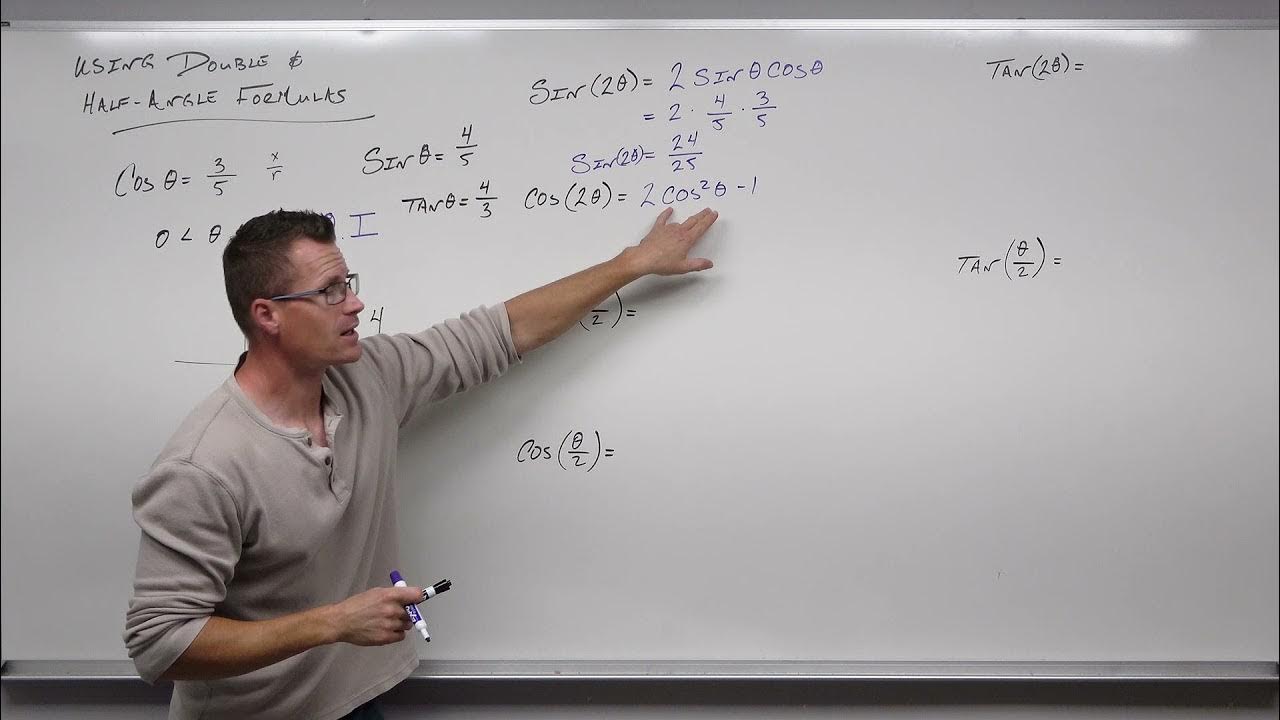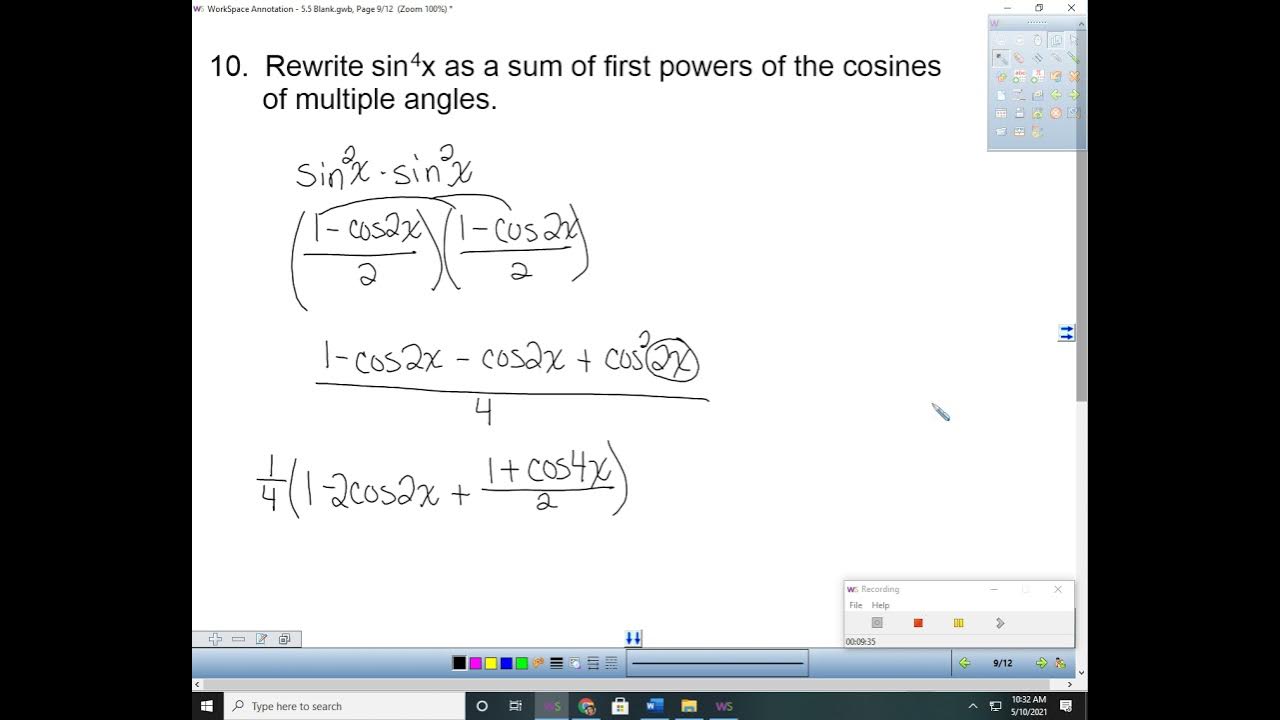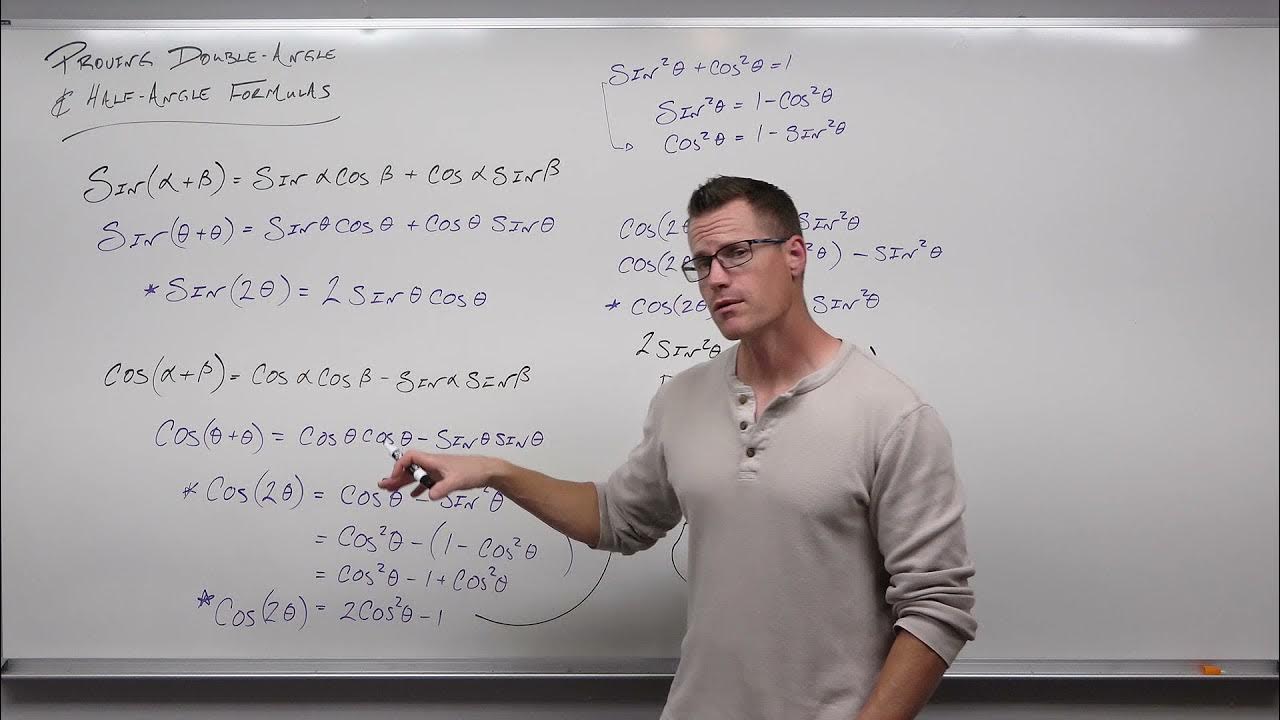5.5 Multiple Angle and Product to Sum Formulas (Part 1)
TLDRThis video covers double-angle and product-to-sum formulas in trigonometry, focusing on solving equations using these identities. The instructor explains the sine, cosine, and tangent double-angle formulas, emphasizing their correct application. Through detailed examples, the video demonstrates factoring and solving trigonometric equations, handling common factors, and using Pythagorean identities. Key problem-solving strategies include factoring, using inverse trigonometric functions, and manipulating algebraic expressions to isolate trigonometric functions. The lesson culminates in converting complex expressions into simplified forms using double-angle formulas.
Takeaways
- 📚 The script discusses double angle formulas in trigonometry, specifically for sine, tangent, and cosine functions.
- 🔍 The formula for sine of double angle (sin(2θ)) is given as 2 * sin(θ) * cos(θ), emphasizing the need to be careful with the angle substitution.
- 📐 The tangent of double angle (tan(2θ)) is presented with the formula 2 * tan(θ) / (1 - tan²(θ)), highlighting its complexity compared to other trigonometric identities.
- 🔄 The script explains the process of solving equations using double angle formulas by factoring and setting factors equal to zero.
- 🧩 The importance of factoring out common terms like cosine x to simplify equations is emphasized, allowing for easier solution of trigonometric equations.
- 🔢 The script demonstrates solving for angles by using inverse trigonometric functions, such as cosine inverse and sine inverse, after setting factors to zero.
- 📉 The script mentions the unit circle and how it can be used to find angles with specific sine and cosine values, particularly when the range is between 0 and 2π.
- 🔄 The process of converting tangent to sine over cosine is explained to simplify equations and facilitate solving for angles.
- 🔍 The script provides a step-by-step approach to solving trigonometric equations, including multiplying through by terms to eliminate denominators and using Pythagorean identities.
- 📌 The script concludes with an example of finding the double angle of a given angle, using the formulas for sin(2θ), tan(2θ), and cos(2θ), and solving for the original angle.
Q & A
What are the double angle formulas for sine, cosine, and tangent?
-The double angle formulas are: - sin(2u) = 2 sin(u) cos(u) - cos(2u) has three forms: cos^2(u) - sin^2(u), 2 cos^2(u) - 1, and 1 - 2 sin^2(u) - tan(2u) = 2 tan(u) / (1 - tan^2(u))
Why are they called double angle formulas?
-They are called double angle formulas because they involve trigonometric functions of double angles (2u), meaning the angle in the formula is twice the angle of the trigonometric function being evaluated.
How do you solve an equation with a double angle formula?
-To solve an equation with a double angle formula, replace the double angle trigonometric function with its equivalent expression, then simplify and solve for the variable by factoring or using inverse trigonometric functions.
What steps are taken to solve the equation sin(2x) + 2 cos(x) = 0?
-1. Replace sin(2x) with 2 sin(x) cos(x). 2. Factor out the common factor, 2 cos(x). 3. Set each factor equal to zero and solve for x. 4. Use the unit circle to find the solutions within the given interval.
How do you find the cosine inverse of 0?
-To find the cosine inverse of 0, look for the angles on the unit circle where the cosine value is 0, which are at π/2 and 3π/2.
What is the process for solving an equation involving tangent double angle formulas?
-1. Replace tan(2x) with 2 tan(x) / (1 - tan^2(x)). 2. Eliminate the denominator by multiplying all terms by (1 - tan^2(x)). 3. Simplify and convert tangent to sine and cosine if necessary. 4. Factor and solve for the variable.
How do you factor a trinomial involving sine and cosine?
-Convert all trigonometric functions to sine or cosine. Identify common factors and use algebraic techniques such as factoring by grouping to simplify the expression into solvable factors.
What are the steps to solve 4 sin^2(x) + 2 sin(x) - 2 = 0?
-1. Identify the trinomial form and factor it into (2 sin(x) - 1)(2 sin(x) + 1) = 0. 2. Set each factor equal to zero and solve for sin(x). 3. Find the angles on the unit circle that correspond to the sine values obtained.
How do you rewrite an expression using double angle identities?
-Identify parts of the expression that match double angle identities and replace them with their equivalent double angle forms, simplifying the expression to a more compact form.
What is the result of the expression 3(2 cos^2(x) - 1) using double angle identities?
-Using the double angle identity, 2 cos^2(x) - 1 is equal to cos(2x). Thus, the expression simplifies to 3 cos(2x).
Outlines
📚 Introduction to Double Angle Formulas
The paragraph introduces the concept of double angle formulas in trigonometry. It explains that these formulas are used to simplify expressions involving multiple angles and are derived from the basic trigonometric functions. The speaker uses examples to illustrate how to apply these formulas, such as converting sine(2u) to 2 * sine(u) * cosine(u). The emphasis is on the importance of understanding that the angle in the formula is actually half of the angle being considered in the problem. The paragraph also demonstrates how to solve equations by factoring and using inverse trigonometric functions.
🔍 Solving Equations with Double Angle Formulas
This paragraph delves deeper into solving trigonometric equations using double angle formulas. The speaker demonstrates how to manipulate equations to isolate sine or cosine functions, and then solve for the angle. The process involves factoring out common terms and setting them equal to zero to find the angle values. The speaker also highlights the importance of considering the interval in which the angles are expected, as this affects the final solutions. Examples include solving for angles where cosine is zero or sine is negative one, and using the unit circle to find the correct angles within the specified range.
🔢 Working with Tangent in Double Angle Equations
The speaker tackles the more complex aspect of double angle formulas involving tangent. They explain how to simplify equations involving tangent by eliminating the denominator, which often contains tangent squared. The process involves multiplying through by the conjugate to clear the denominator and then simplifying the resulting expression. The speaker also discusses the challenges of solving for tangent and how to convert tangent expressions into sine and cosine to facilitate solving the equations. The goal is to isolate sine or cosine to find the angle values.
📉 Converting Trigonometric Expressions to Sine
This paragraph focuses on converting trigonometric expressions into a form that can be solved using sine. The speaker demonstrates how to rewrite cosine squared as 1 - sine squared, using the Pythagorean identity. This transformation allows for the equation to be simplified into a form that can be factored and solved. The process involves distributing and combining like terms to isolate sine, and then solving for the angle using inverse trigonometric functions. The speaker also emphasizes the importance of checking the solutions against the original equation.
📐 Applying Double Angle Formulas to a Triangle Problem
The speaker applies the double angle formulas to a specific triangle problem, where the angle theta is between 3π/2 and 2π. They use the given values of sine and cosine to find the values of sine(2θ), tangent(2θ), and cosine(2θ). The process involves plugging in the values into the double angle formulas and performing the necessary calculations. The speaker also explains how to rewrite the results as double angle expressions, demonstrating a clear understanding of the relationship between single and double angles in trigonometry.
🧩 Simplifying Trigonometric Expressions Using Identities
In this paragraph, the speaker simplifies a trigonometric expression by using trigonometric identities. They demonstrate how to combine terms and use the identity cosine²x - sine²x = cosine(2x) to simplify the expression further. The process involves factoring out common terms and recognizing patterns that can be simplified using known identities. The speaker also shows how to multiply trigonometric functions and simplify the result, ultimately expressing the result in terms of cosine(2x).
Mindmap
Keywords
💡Double Angle Formulas
💡Sine 2u
💡Cosine 2u
💡Tangent 2u
💡Factoring
💡Unit Circle
💡Inverse Trigonometric Functions
💡Pythagorean Identities
💡Trigonometric Equations
💡Common Factors
Highlights
Introduction to double angle formulas: sine, tangent, and cosine.
Explanation of sine 2u formula: 2 sine u cosine u.
Tangent 2u formula: 2 tangent u / (1 - tangent squared u).
Three versions of cosine 2u formula: different forms depending on given information.
Method of solving equations involving double angle formulas.
Factor out common factors in equations to simplify solving.
Example problem: Solving for x when cosine x equals 0 and sine x equals -1.
Using unit circle to find solutions within the interval 0 to 2 pi.
Second example problem: Replacing double angle with its equivalent in equations.
Factoring out common terms like cosine x to simplify equations.
Solving for angles with specific sine and cosine values using inverse functions.
Introduction to tangent double angle formula and solving complex equations.
Converting tangent to sine over cosine to simplify equations.
Dealing with denominators by multiplying through the equation.
Using Pythagorean identities to rewrite trigonometric terms and simplify equations.
Transcripts
Browse More Related Video

How to Use the Double and Half Angle Formulas for Trigonometry (Precalculus - Trigonometry 28)

Precalc Chapter 5 Review

5.4.1 Double-Angle Identities

5.5 Multiple Angle and Product to Sum Formulas (Part 2)

Trig Identities

Proving the Double and Half Angle Formulas for Trigonometry (Precalculus - Trigonometry 27)
5.0 / 5 (0 votes)
Thanks for rating: